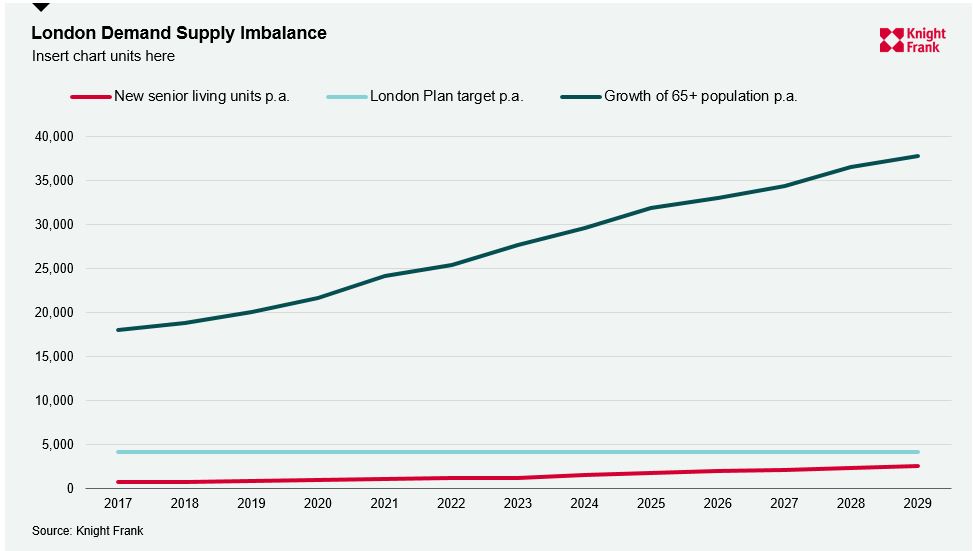Planning remains key to unlocking development opportunities for the Senior Living market
The vast majority of councils across England are underprepared to provide suitable housing for seniors.
4 minutes to read
More than half of the local authorities in England do not have clear planning policies in place to support housing for seniors, according to the results of a joint study by Knight Frank and law firm Irwin Mitchell.
By 2037, it is forecast that one in four people in the country will be over 65. Yet, as the analysis makes clear, there remains a crisis in planning policy which needs to be addressed if we are to ensure a suitable, age-appropriate choice of housing for all individuals in their later life.
As Jason Leek, CEO of senior living housing developer Riverstone, notes in the report: “People are living longer and it is vital that they are provided with an appropriate choice of how they could live their later years. These communities form a core part of this proposition.
“As the sector becomes more widely discussed and understood we want to see increased adoption of retirement communities within Government frameworks and an improved understanding of the benefits that they can deliver.”
Out of 322 local authorities, just 60 (18.6%) were graded A – which means they have clear policies in place and specific site allocations given for housing for seniors. Some 161 (50%) were awarded the lowest D grade.
By overlaying these planning rankings with data considering wider demographic changes and economic indicators, the research identifies ten “opportunity areas” for both private and affordable development, as set out in the table below.

There are three interesting observations which can be made about the results.
- Firstly, that those local authorities with an excellent planning policy in place with regards to seniors housing do not necessarily offer the greatest opportunities when also taking into account demographic changes. Some 16% of local authorities given an A rating for planning also have the lowest overall opportunity score.
- Secondly, very few large cities appear to be close to addressing the challenges posed by housing an ageing population, a fact which appears to be down to inadequate planning policy. Of the major regional cities reviewed, only Leeds and Manchester have a planning score higher than D. Leeds, which has an A rating, performs comparatively well overall.
- And finally, that London is faring badly, despite being home to the nation’s top 10 ageing local authorities. Just over 700 senior living homes were built per annum between 2017 and 2019, against an annual target of more than 4,000.
Lauren Harwood, Head of Senior Living Research at Knight Frank, says: “There is currently a huge supply and demand imbalance of senior housing in England, which is widening amidst a growing and ageing population. It is vital to increase provision, and it is worrying that we are not doing enough yet to address this. Not only for our older population, but also because encouraging downsizing and moves to appropriate housing has been shown to benefit society more broadly.”

Nicola Gooch, Planning Partner at Irwin Mitchell, adds: “We need all local authorities to take the same approach if we are to unlock the potential of senior housing in England. There has been a marked improvement in the number of local authorities planning for seniors housing in recent years, but there is still a long way to go before the necessary support is in place to deliver our population’s elderly housing needs in full.”
“The current patchwork approach to local plans is holding back the development of the sector and needs to end. A national and local policy framework that works to promote a uniform and supportive approach to senior housing is required.”
To read the full report please click here [https://irwinmitchell.turtl.co/story/unlocking-potential-for-senior-living/]
NB.
The UK seniors housing sector can be broadly broken into two products – retirement housing and extra care (also called housing with care). There are two planning uses and two products. Extra care is typically C2 planning use and schemes have larger amenity areas where they can deliver higher levels of service and care to residents in a community setting. Retirement housing (can also be called age restricted housing) typically has a C3 planning (residential) use (sometimes age restricted at 55 or 60 years) and schemes typically have lower levels of amenity areas. National and local planning policy for C2 use should have a clearly defined and supportive affordable housing and CIL polices, supportive policy to assist delivery, site allocations and a defined number of homes required per annum to meet local need. A C3 use will have different policies in line with the residential use class.